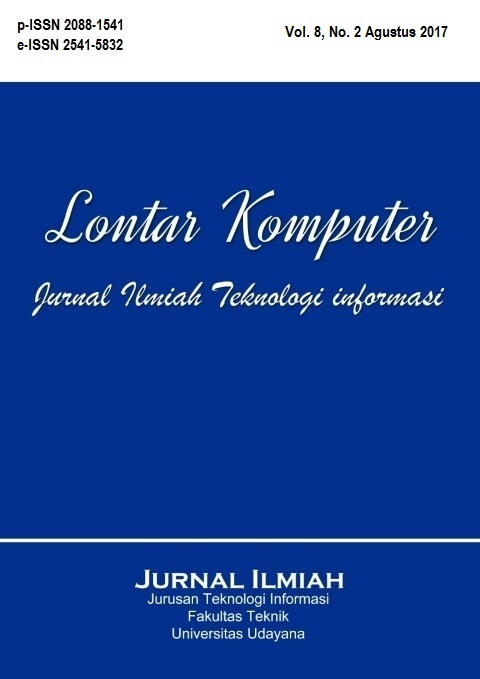Permainan Edukasi Labirin Virtual Reality Dengan Metode Collision Detection Dan Stereoscopic
Abstract
General knowledge is the knowledge most people know about. LIPI (Indonesian Institute of Sciences) Survey’s in 2015 states 54% of 1,829 respondents are less aware of knowledge and technology information. Most Indonesians prefer using internet for social media rather than seeking information about knowledge or issues in society [1]. This problem can be overcome with more interactive educational media, so can add insight of general knowledge in fun way. Virtual Reality is technology capable of creating interactive virtual environment. Virtual Reality is used to create educational game called LabirinVR. LabirinVR created using GoogleVR SDK with Collision Detection and Stereoscopic Vision Methods. Game interactions utilize Accelerometer and Gyroscope sensors. The application is able to increase the ability of thinking, creativity, and insight of general knowledge of Indonesia and the world. The application function test result is 100% valid and has 98% feasibility level, so it has good UAT (User Acceptence Test) [2], accepted and used by the people.
Downloads
References
[2] https://usersnap.com/blog/user-acceptance-testing-right/ [diakses 23 Maret 2017]
[3] C. W. Nielsen and M. a. Goodrich, "Comparing the usefulness of video and map information in navigation tasks", Proceeding 1st ACM SIGCHI/SIGART Conf. Human-robot Interact. - HRI ’06, p. 95, 2006.
[4] M. E. Bredemeier, C. S. Greenblat, “The Educational Effectiveness of Simulation Games: A Synthesis of Findings”, Simulation & Games, 12(3), pp. 307-332, 1981.
[5] J. Yap, “Virtual World Labyrinth: An Interactive Maze That Teaches Computing”, Defense Science Research Conference and Expo (DSR), 2011, 2011.
[6] S. Mathew, “Importance of Virtual Reality in Current World”, International Journal of Computer Science and Mobile Computing, vol. 3, no. 3, pp. 894-899, 2014.
[7] D. Levac, M. R. Pierrynowski, M. Canestraro, L. Gurr, L. Leonard, C. Neeley, “Exploring Children’s Movement Characteristics During Virtual Reality Video Game Play”, Human Movement Science, vol. 29, no. 6, pp. 1023-1038, 2010.
[8] I. P. A. E. Pratama, Sistem Informasi dan Implementasinya, Bandung: Informatika Bandung, pp. 28-35, 2014.
[9] R. D. Putra, M. Aswin, D. W. Djuriatno, "Pencarian Rute Terdekat Pada Labirin Menggunakan Metode A*", EECCIS, vol. 6, no. 2, pp. 1-4, 2012.
[10] U. Asfari, B. Setiawan, A. Sani, “Pembuatan Aplikasi Tata Ruang Tiga Dimensi Gedung Serba Guna Menggunakan Teknologi Virtual Reality (Studi Kasus: Graha ITS Surabaya)”, Jurnal Teknik ITS, vol. 1, no. 1, pp. A540-A544, 2012.
[11] I. D. G. W. Dhiyatmika, I. K. G. D. Putra, N. M. I. M. Mandenni, "Aplikasi Augmented Reality Magic Book Pengenalan Binatang untuk Siswa TK", Lontar Komputer: Jurnal Ilmiah Teknologi Informasi, vol. 6, no. 2, pp. 120–127, 2015.
[12] I. G. A. Nugraha, I. K. G. D. Putra, I. M. Sukarsa, "Rancang Bangun Aplikasi Augmented Reality Museum Bali Berbasis Android Studi Kasus Gedung Karangasem dan Gedung Tabanan", Lontar Komputer: Jurnal Ilmiah Teknologi Informasi, vol. 7, no. 2, pp. 93–103, 2016.
[13] S. Redon, A. Kheddar, and S. Coquillart, "Fast Continuous Collision Detection Between Rigid Bodies", Computer Graphics Forum, vol. 21, no. 3, pp. 279-287, 2002.
[14] M. K. Ponamgi, D. Manocha, and M. C. Lin, "Incremental Algorithms for Collision Detection Between Polygonal Models”, IEEE Transactions on Visualization and Computer Graphics, vol. 3, no. 1, pp. 51-64, 1997.
[15] https://developer.mozilla.org/en-US/docs/Web/API/WebVR_API/Concepts. [diakses tanggal 25 Februari 2017]
The Authors submitting a manuscript do so on the understanding that if accepted for publication, the copyright of the article shall be assigned to Jurnal Lontar Komputer as the publisher of the journal. Copyright encompasses exclusive rights to reproduce and deliver the article in all forms and media, as well as translations. The reproduction of any part of this journal (printed or online) will be allowed only with written permission from Jurnal Lontar Komputer. The Editorial Board of Jurnal Lontar Komputer makes every effort to ensure that no wrong or misleading data, opinions, or statements be published in the journal.
 This work is licensed under a Creative Commons Attribution 4.0 International License.
This work is licensed under a Creative Commons Attribution 4.0 International License.























